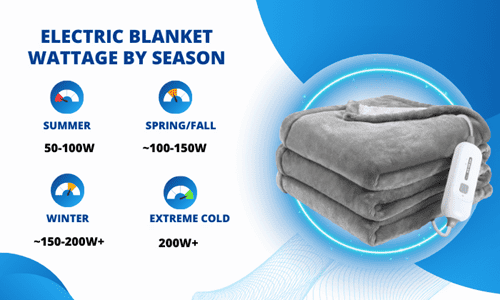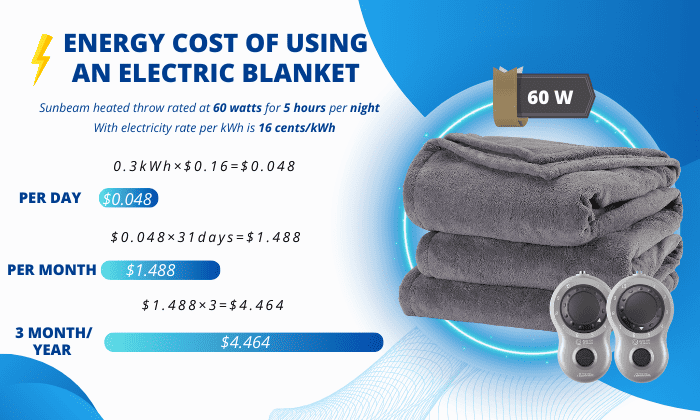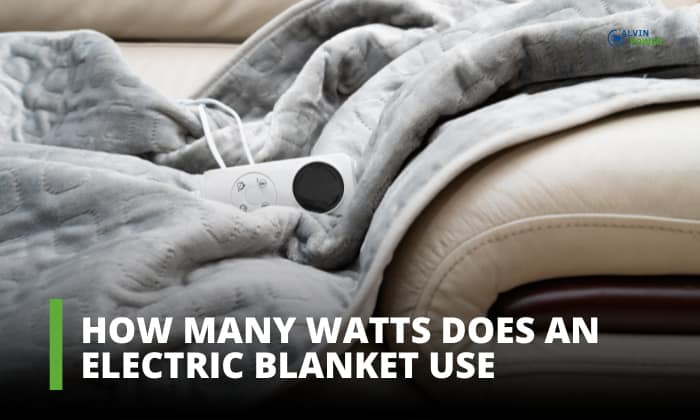How Many Watts Does Electric Blanket Use

One of the most frustrating experiences for homeowners, especially during the colder months, is an inconsistent or inadequate heating system. You set your thermostat, anticipating cozy warmth, but instead, you're left shivering. This can manifest in various ways: some rooms are too cold while others are stuffy, the furnace cycles on and off too frequently, or worse, it doesn’t seem to be heating at all. While a malfunctioning HVAC system is a common culprit, sometimes the solution lies in smaller, individual heating appliances like electric blankets. Before you call an expensive HVAC technician, let's explore the world of electric blankets and understand how many watts they use, which can often explain unexpected spikes in energy consumption and even uncover blanket malfunctions.
Understanding Electric Blanket Wattage and Usage
Electric blankets provide targeted warmth, making them a popular choice for adding comfort to beds and sofas. However, their energy consumption can vary significantly. Knowing the wattage of your electric blanket is the first step in understanding its energy usage and troubleshooting potential issues.
Locating the Wattage Information
Finding the wattage information is usually quite straightforward. Look for it in these common places:
- The Blanket's Label: This is the most common location. Examine the label attached to the blanket itself. It's usually near the power cord or along a seam. Look for a section that says "Specifications," "Power," or something similar. You should find the wattage listed (e.g., 100W, 150W).
- The Controller: Some blankets have the wattage information printed on the controller. Check the back or bottom of the controller unit.
- The Original Packaging: If you still have the box or packaging the blanket came in, the wattage should be clearly displayed.
- The User Manual: The user manual that came with your blanket is another excellent resource. It will likely include the wattage and other important specifications.
- Manufacturer's Website: If you can't find the information elsewhere, search online for your blanket's make and model. The manufacturer's website usually provides detailed product specifications.
Once you find the wattage, note it down. This number is crucial for calculating energy costs and identifying potential problems.
Typical Wattage Ranges
Electric blanket wattage typically falls within these ranges:
- Single Size: 60W - 100W
- Twin Size: 80W - 120W
- Full Size: 100W - 150W
- Queen Size: 120W - 180W
- King Size: 150W - 200W
Keep in mind that these are just averages. The actual wattage can vary depending on the brand, model, and features of the blanket. Some blankets with advanced features, such as multiple heat zones or timers, may consume more power.
Troubleshooting Electric Blanket Heating Issues
If your electric blanket isn't heating properly, don't immediately assume it's a lost cause. There are several DIY checks you can perform before seeking professional help. These checks are simple and safe, and can often identify the problem quickly.
Step 1: Visual Inspection (No Tools Required)
Start with a thorough visual inspection. This doesn't require any tools and can reveal obvious issues.
- Check the Power Cord: Look for any signs of damage to the power cord, such as frayed wires, cuts, or kinks. A damaged power cord can prevent the blanket from receiving power. Never use a blanket with a damaged power cord! This is a serious fire hazard.
- Inspect the Controller Cord: Examine the cord that connects the blanket to the controller. Look for similar signs of damage, such as fraying or cuts.
- Examine the Controller: Check the controller for any physical damage, such as cracks or broken buttons. Make sure the controller is securely connected to the blanket.
- Look for Burnt Spots: Carefully inspect the blanket for any burnt spots or areas that feel unusually stiff. These could indicate internal damage to the heating elements. If you find any, discontinue use immediately.
- Smell for Burning Odors: Sniff the blanket and controller for any unusual burning smells. A burning odor could indicate a short circuit or other electrical problem.
If you find any damage during the visual inspection, do not use the blanket. Continuing to use a damaged electric blanket could be dangerous.
Step 2: Power and Connections (No Tools Required)
Next, verify the power supply and connections.
- Check the Outlet: Make sure the blanket is plugged into a working outlet. Test the outlet with another device, such as a lamp or phone charger.
- Try a Different Outlet: If the outlet isn't working, try plugging the blanket into a different outlet.
- Ensure Secure Connections: Make sure the power cord is securely plugged into the outlet and the controller is securely connected to the blanket. A loose connection can prevent the blanket from heating.
- Check the Controller Settings: Ensure the controller is turned on and set to the desired heat level. Some controllers have multiple settings, so experiment with different levels to see if that makes a difference.
Step 3: Testing with a Multimeter (Basic Equipment Required)
If the visual inspection and power checks don't reveal the problem, you can use a multimeter to test the blanket's electrical continuity. This step requires basic electrical knowledge and a multimeter. If you're not comfortable working with electricity, skip this step and consult a qualified electrician.
- Safety First: Unplug the blanket from the outlet before testing.
- Continuity Test: Set the multimeter to the continuity setting (usually indicated by a beep symbol).
- Test the Power Cord: Touch one probe of the multimeter to one prong of the power cord and the other probe to the corresponding wire inside the controller plug (you may need to carefully open the controller plug to access the wires). Repeat for the other prong and wire. If the multimeter doesn't beep, the power cord is likely broken and needs to be replaced.
- Test the Heating Element: Locate the wires connecting the controller to the heating element within the blanket (again, this may require carefully opening the controller plug). Touch one probe of the multimeter to one wire and the other probe to the other wire. If the multimeter doesn't beep, the heating element may be broken. Note: It can be difficult to properly assess the heating element without more advanced equipment. A lack of continuity doesn't always mean the element is definitively broken.
Important Safety Note: If you find a short circuit (very low resistance reading) during the continuity test, do not use the blanket. A short circuit is a serious fire hazard.
Step 4: Calculating Energy Consumption
Knowing the wattage of your electric blanket allows you to estimate its energy consumption and associated costs. This can help you determine if the blanket is using an unexpectedly high amount of energy, which could indicate a malfunction.
- Calculate Daily Energy Use: Multiply the blanket's wattage by the number of hours you use it per day, and then divide by 1000 to get kilowatt-hours (kWh). For example, if your blanket uses 100 watts and you use it for 8 hours per day, the calculation would be (100 watts * 8 hours) / 1000 = 0.8 kWh.
- Calculate Monthly Energy Use: Multiply the daily kWh by the number of days in the month. For example, 0.8 kWh/day * 30 days = 24 kWh per month.
- Calculate Monthly Cost: Multiply the monthly kWh by your electricity rate (check your electricity bill for the rate per kWh). For example, if your electricity rate is $0.15 per kWh, the monthly cost would be 24 kWh * $0.15/kWh = $3.60.
If the calculated energy consumption is significantly higher than you expect, it could indicate a problem with the blanket's thermostat or heating element.
When to Call a Professional
While many electric blanket issues can be resolved with simple DIY checks, some problems require professional attention. Do not attempt to repair an electric blanket if you are not comfortable working with electricity or if you encounter any of the following situations:
- Damaged Power Cord or Controller Cord: If the power cord or controller cord is damaged, do not use the blanket. Replacing the cord requires specialized knowledge and tools. Contact a qualified electrician or appliance repair technician.
- Burnt Spots or Burning Odors: If you find burnt spots on the blanket or smell a burning odor, do not use the blanket. These are signs of a serious electrical problem. Contact a qualified electrician or appliance repair technician.
- Short Circuit: If you find a short circuit during the continuity test, do not use the blanket. This is a serious fire hazard. Contact a qualified electrician or appliance repair technician.
- Controller Malfunction: If the controller doesn't seem to be working properly, even after checking the connections, it may need to be replaced. Contact the blanket manufacturer or a qualified appliance repair technician.
- Internal Damage: If you suspect internal damage to the heating element or other components, it's best to consult a professional. Attempting to repair internal components yourself could be dangerous.
- You Are Uncomfortable: If at any point during the troubleshooting process you feel uncomfortable or unsure, stop and contact a qualified professional. It's better to be safe than sorry when dealing with electricity.
Preventative Maintenance
To extend the life of your electric blanket and prevent problems, follow these preventative maintenance tips:
- Follow Washing Instructions: Carefully follow the manufacturer's washing instructions. Most electric blankets can be machine washed on a gentle cycle, but always check the label first.
- Do Not Dry Clean: Do not dry clean electric blankets. The chemicals used in dry cleaning can damage the heating elements.
- Do Not Iron: Do not iron electric blankets. The heat from the iron can damage the heating elements.
- Store Properly: When not in use, store the blanket loosely folded or rolled up. Do not crease or fold it tightly, as this can damage the heating elements.
- Inspect Regularly: Regularly inspect the blanket for any signs of damage, such as frayed wires or burnt spots.
- Replace When Necessary: Electric blankets have a limited lifespan. If your blanket is old or showing signs of wear and tear, it's best to replace it with a new one.
By understanding your electric blanket's wattage, performing basic troubleshooting steps, and following preventative maintenance tips, you can keep your blanket working safely and efficiently for years to come. Remember, if you're ever unsure about a repair, it's always best to consult a qualified professional.










